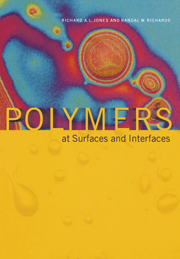Book contents
- Frontmatter
- Contents
- Preface
- 1 Introduction and overview
- 2 The surface of a simple polymer melt
- 3 Experimental techniques
- 4 Polymer/polymer interfaces
- 5 Adsorption and surface segregation from polymer solutions and mixtures
- 6 Tethered polymer chains in solutions and melts
- 7 Adhesion and the mechanical properties of polymer interfaces at the molecular level
- 8 Polymers spread at air/liquid interfaces
- Index
3 - Experimental techniques
Published online by Cambridge University Press: 19 January 2010
- Frontmatter
- Contents
- Preface
- 1 Introduction and overview
- 2 The surface of a simple polymer melt
- 3 Experimental techniques
- 4 Polymer/polymer interfaces
- 5 Adsorption and surface segregation from polymer solutions and mixtures
- 6 Tethered polymer chains in solutions and melts
- 7 Adhesion and the mechanical properties of polymer interfaces at the molecular level
- 8 Polymers spread at air/liquid interfaces
- Index
Summary
Introduction
The recent rapid development in the quantitative description of polymer surfaces and interfaces has, to a large extent, been driven by the development of a variety of powerful experimental techniques. The newcomer to the field might be forgiven for feeling some confusion in the face of this profusion, not least because of the seemingly unstoppable urge of surface scientists to maximise the use of unpronounceable acronyms. Many books and review articles already describe the technicalities of each of these techniques, so our aim in this chapter is to review the physical principles underlying them so that we can distinguish between the different classes of information that each technique is best able to provide.
Broadly speaking, experimental information about the nature of polymer surfaces and interfaces is available in three broad classes, composition, structure and morphology and properties. Let us discuss each in turn.
Perhaps the most obvious question we can ask about a polymer surface is what it is composed of. Compositional information may be restricted to an elemental analysis, or we may be able to obtain more specific information about the chemical species that are present. Alternatively, it may be possible only to detect the presence of a restricted set of elements or compounds.
- Type
- Chapter
- Information
- Polymers at Surfaces and Interfaces , pp. 56 - 126Publisher: Cambridge University PressPrint publication year: 1999



